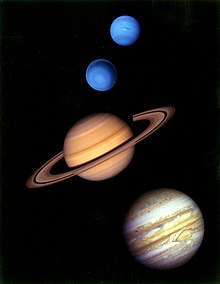Outer Solar System
The outer region of the Solar System is home to the gas giants and their large moons. Many short period comets, including the centaurs, also orbit in this region. Due to their greater distance from the Sun, the solid objects in the outer Solar System contain a higher proportion of volatiles such as water, ammonia and methane, than the rocky denizens of the inner Solar System, as the colder temperatures allow these compounds to remain solid.Outer planets
Main articles: Outer planets and Gas giant
The four outer planets, or gas giants (sometimes called Jovian planets), collectively make up 99 percent of the mass known to orbit the Sun.[c] Jupiter and Saturn are each many tens of times the mass of the Earth and consist overwhelmingly of hydrogen and helium; Uranus and Neptune are far less massive (<20 Earth masses) and possess more ices in their makeup. For these reasons, some astronomers suggest they belong in their own category, “ice giants.”[54] All four gas giants have rings, although only Saturn's ring system is easily observed from Earth. The term outer planet should not be confused with superior planet, which designates planets outside Earth's orbit and thus includes both the outer planets and Mars.Jupiter
- Jupiter (5.2 AU), at 318 Earth masses, is 2.5 times the mass of all the other planets put together. It is composed largely of hydrogen and helium. Jupiter's strong internal heat creates a number of semi-permanent features in its atmosphere, such as cloud bands and the Great Red Spot.
- Jupiter has 63 known satellites. The four largest, Ganymede, Callisto, Io, and Europa, show similarities to the terrestrial planets, such as volcanism and internal heating.[55] Ganymede, the largest satellite in the Solar System, is larger than Mercury.
Saturn
- Saturn (9.5 AU), distinguished by its extensive ring system, has several similarities to Jupiter, such as its atmospheric composition and magnetosphere. Although Saturn has 60% of Jupiter's volume, it is less than a third as massive, at 95 Earth masses, making it the least dense planet in the Solar System. The rings of Saturn are made up of small ice and rock particles.
- Saturn has 62 confirmed satellites; two of which, Titan and Enceladus, show signs of geological activity, though they are largely made of ice.[56] Titan, the second largest moon in the Solar System, is larger than Mercury and the only satellite in the Solar System with a substantial atmosphere.
Uranus
- Uranus (19.6 AU), at 14 Earth masses, is the lightest of the outer planets. Uniquely among the planets, it orbits the Sun on its side; its axial tilt is over ninety degrees to the ecliptic. It has a much colder core than the other gas giants, and radiates very little heat into space.[57]
- Uranus has 27 known satellites, the largest ones being Titania, Oberon, Umbriel, Ariel and Miranda.
Neptune
- Neptune (30 AU), though slightly smaller than Uranus, is more massive (equivalent to 17 Earths) and therefore more dense. It radiates more internal heat, but not as much as Jupiter or Saturn.[58]
- Neptune has 13 known satellites. The largest, Triton, is geologically active, with geysers of liquid nitrogen.[59] Triton is the only large satellite with a retrograde orbit. Neptune is accompanied in its orbit by a number of minor planets, termed Neptune Trojans, that are in 1:1 resonance with it.
Comets
Main article: Comet
 Comets are small Solar System bodies,[e] typically only a few kilometres across, composed largely of volatile ices. They have highly eccentric orbits, generally a perihelion within the orbits of the inner planets and an aphelion far beyond Pluto. When a comet enters the inner Solar System, its proximity to the Sun causes its icy surface to sublimate and ionise, creating a coma: a long tail of gas and dust often visible to the naked eye.
Comets are small Solar System bodies,[e] typically only a few kilometres across, composed largely of volatile ices. They have highly eccentric orbits, generally a perihelion within the orbits of the inner planets and an aphelion far beyond Pluto. When a comet enters the inner Solar System, its proximity to the Sun causes its icy surface to sublimate and ionise, creating a coma: a long tail of gas and dust often visible to the naked eye.Short-period comets have orbits lasting less than two hundred years. Long-period comets have orbits lasting thousands of years. Short-period comets are believed to originate in the Kuiper belt, while long-period comets, such as Hale-Bopp, are believed to originate in the Oort cloud. Many comet groups, such as the Kreutz Sungrazers, formed from the breakup of a single parent.[60] Some comets with hyperbolic orbits may originate outside the Solar System, but determining their precise orbits is difficult.[61] Old comets that have had most of their volatiles driven out by solar warming are often categorised as asteroids.[62]
Centaurs
Main article: Centaur (minor planet)
The centaurs are icy comet-like bodies with a semi-major axis greater than Jupiter's (5.5 AU) and less than Neptune's (30 AU). The largest known centaur, 10199 Chariklo, has a diameter of about 250 km.[63] The first centaur discovered, 2060 Chiron, has also been classified as comet (95P) since it develops a coma just as comets do when they approach the Sun.
No comments:
Post a Comment